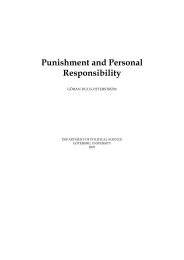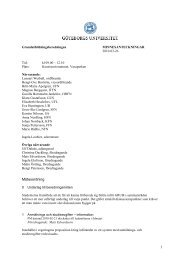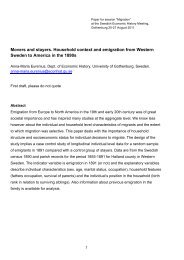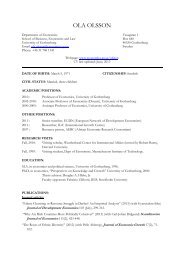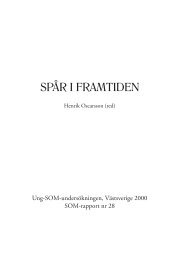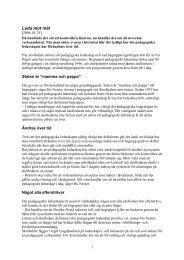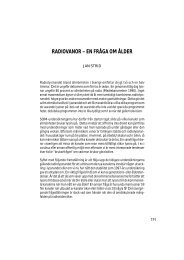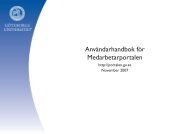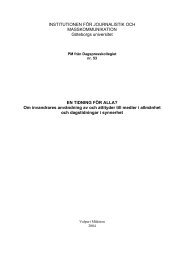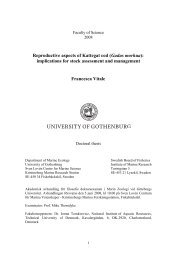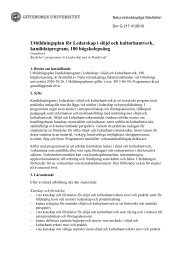ÅSKA I SVERIGE UNDER 1900-TALET - Göteborgs universitet
ÅSKA I SVERIGE UNDER 1900-TALET - Göteborgs universitet
ÅSKA I SVERIGE UNDER 1900-TALET - Göteborgs universitet
You also want an ePaper? Increase the reach of your titles
YUMPU automatically turns print PDFs into web optimized ePapers that Google loves.
ABSTRACT<br />
Thunder in Sweden during the 20th century<br />
The purpose of this study is to examine the frequency of lightning at seven different stations<br />
around Sweden over the past 100 years, and to ascertain if there has been a change in pattern.<br />
If so, if the changes have occurred in different regions and what special characteristics each<br />
station has that causes the lightening frequency to change, either in terms of months, or years.<br />
The stations have been chosen so that the whole country is represented and include; Lund,<br />
Göteborg, Växjö, Kalmar, Gävle, Östersund and Umeå. From relevant weather stations,<br />
lightning statistics have been collected and recorded. The regional differences showed that<br />
lightning is more prevalent further inland, than by the coast. Växjö had more days when<br />
lightning was recorded, than any other station. Umeå had least number of days. The number<br />
of days with lightning decreased the further north the station was located.<br />
Each year was divided into monthly list of the days lightning was recorded. This allowed a<br />
examination of the time of year in which lightning frequency may have changed. Generally<br />
speaking all stations received more lightning during the summer months, with Växjö at the<br />
top of the list. From autumn up until January, Göteborg had the highest number of days<br />
recording lightning. The reason for this is that Göteborg has most of it’s lightning days from<br />
September to January as it is situated next to the coast and affected by the warmth of the sea.<br />
Also relevant is the fact that winter lightning usually occurs during the fronts driven towards<br />
Göteborg by the prevailing west winds. Göteborg is affected first as the fronts are forced to<br />
rise as they cross the coast.<br />
During the 20 th century the lightning frequency has varied greatly between years and stations.<br />
Some stations have had a lightning frequency that has tended to change in waves over a time<br />
span. This is shown clearly by Gävle. During the whole century the lightning frequency has<br />
increased in six of seven stations. This increase has been more pronounced in the south, rather<br />
than the north. By looking at the whole century it can be seen that the lightning frequency has<br />
increased more towards the end of the period. This may have been caused by climate changes<br />
which result in increased temperature, with more water vapour in the atmosphere. This creates<br />
favourable conditions for the clouds to develop which are the birth place of lightning. 1997<br />
was the warmest year since 1861. This was reflected by the increase of days on which<br />
lightning occurred at all stations.<br />
North Atlantic Oscillation (NAO) is the variation between the high pressure over the Azores<br />
and the Icelandic low. A comparison between NAO and lightning has been made in July<br />
during the 20 th century. The result is that NAO has effect on the frequency of lightning. The<br />
variation in NAO both correlate and diverge with lightning during some part of the period.<br />
1




